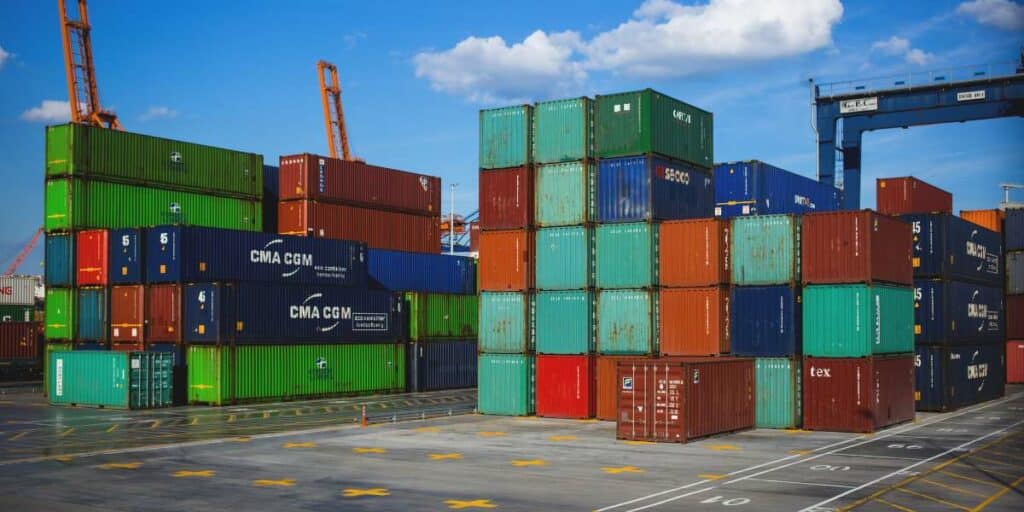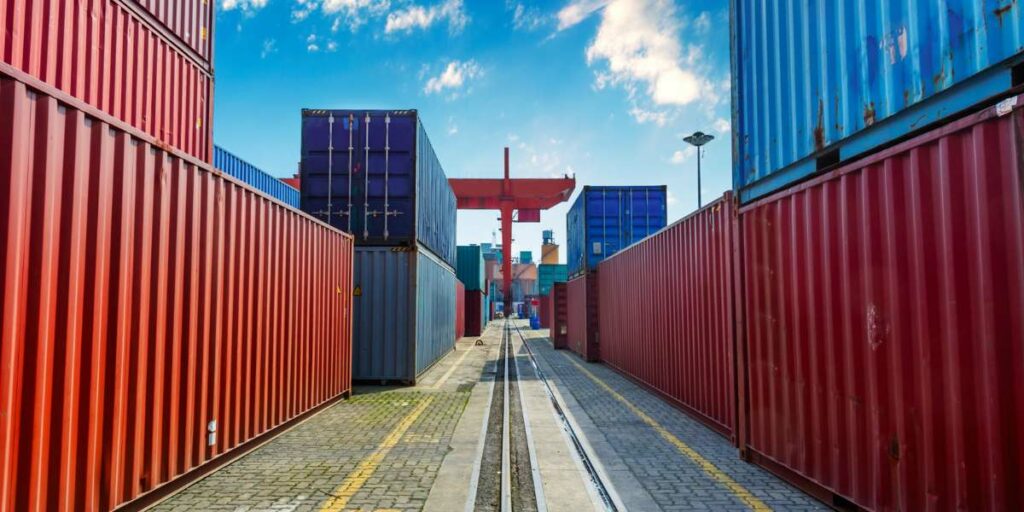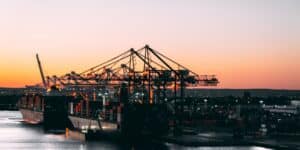Approximately 11 billion tons of goods are transported by sea annually, and the demand for maritime transportation is expected to continue increasing, reaching 16 billion tons in 2028. 90% of the internationally traded cargo is carried by sea, and over 60% is loaded in containers. Various types of containers are utilized by shippers and carriers, depending on the nature of the loads they carry.
What is container shipping?
Container transport consists of moving goods in standardized and re-sealable transportation boxes, commonly carried out via sea or rail routes. Container shipping has become the preferred method for transporting goods across the oceans, given that a staggering 90% of non-bulk cargo worldwide is transported by containers.
With approximately 65 million of these containers in active use worldwide, mainly owned and managed by leasing companies, they have become a cornerstone of the shipping industry.
The volume of sea shipping is commonly measured in metric tons or TEUs (Twenty-foot Equivalent Units), which is based on a 20-foot container’s length (approximately 6.10 meters). This unit provides a standardized measure for calculating a container capacity, as well as a container vessel or terminal’s capacity. For instance, MSC Irina and MSC Loreto can hold up to 24,346 TEU, making them the world’s largest container ships in 2023.
It is important to notice that not all goods are containerized for ocean carriage. Other types of freight are carried loose (without defined load units) or in bags, boxes drums, or pallets. These are classified as “bulk cargo” and are placed directly into the cargo hold of the ship.
Here we are talking about:
- lumber in bundles, paper in rolls, steel, and vehicles.
- liquid bulk cargo, mainly petroleum products, liquid nitrogen, oils, LNG (Liquefied Natural Gas), and chemicals, carried on tankers.
- Dry bulk cargo, such as coal, copper, iron ore, grains, limestone, bauxite, wood, and sand. These materials are transported in large quantities without packaging, in specialized bulk carriers.
However, they only amount to 3,272 million tons loaded in 2021, according to Statista’s latest report.

What are the types of containers?
There are several types of containers used for sea shipping and storage, each designed to accommodate different types of cargo. Some of the common types of containers include:
- Dry containers: This is the standard and most widely used container. It is enclosed and weatherproof, suitable for transporting general cargo, dry goods, and manufactured goods.
- Reefer containers (Refrigerated Container): Equipped with temperature control systems, reefer containers are used for transporting perishable goods, such as fruits, vegetables, pharmaceuticals, and certain chemicals.
- Flat rack containers: These containers have collapsible sides and no roof, allowing for the transportation of oversized or irregularly shaped cargo, such as machinery, vehicles, and large equipment.
- Open-top containers: Similar to dry containers, but with a removable top, open-top containers are used for loading cargo from the top, making them ideal for tall or bulky items.
- Tank containers: These containers are designed to transport liquid or gaseous cargo, such as chemicals, fuels, and food-grade products.
- Ventilated containers: Featuring openings or ventilation systems, ventilated containers are used for goods that require air circulation, like certain agricultural products.
- Insulated thermal containers: Insulated containers are used to transport cargo that requires temperature control, but not necessarily refrigeration. They provide protection from extreme temperature fluctuations.
- Open side containers: These containers have full side access doors, enabling easy loading and unloading of cargo from the sides, making them suitable for certain types of goods.
- Platform containers (Flatbed container): A simple container with no sides or roof, used for carrying heavy, oversized, or awkwardly shaped cargo.
Each type of container serves specific purposes and allows for efficient and secure transportation of various goods across the seas.
Containers also come in a variety of sizes. Here are the internal dimensions per container type, along with the maximum capacity, both in volume (expressed in cubic meters) and chargeable weight (expressed in kilograms).
How to Track a Ship In Real-Time ?
Let us look at how a ships’ real-time tracker works, its details and features, its benefits for all players in the shipping sector but also its weaknesses…
- 20-foot (standard) container (20 ft)
This container is 2.35 m (7.7 ft) wide, 5.89 meters (19.4 ft) long and 2.39 meters (7.9 ft) high. It has a capacity of 33.2 cubic meters and chargeable weight of 25,000 kg.
- 40-foot (standard) container (40 ft)
This container is 2.35 m (7.8 ft) wide, 12.03m (39.5ft) long and 2.39 meters (7.9 ft) high. It has a maximum capacity of 67.7 cubic meters (2,390 cubic feet), and can carry up to 30,480 kg for general purpose containers. 40 ft containers flat racks can handle loads of up to 60,000 kg, whereas 40 ft reefer containers have a maximum weight capacity of 35,000 kg.

- 40-foot High Cube Container (40 ft HC)
The distinction of the high cube 40 ft container lies in its increased height, measuring 2.67 meters (8.9 feet), as opposed to the standard 2.39 meters (7.9 feet). A 40 ft high cube container has a maximum capacity of 76.4 cubic meters and a maximum chargeable weight of 26,512 kg.
- 45-foot standard container (45 ft)
This container is 2.35 m (7.8 ft) wide, 13.55 m (44.5 ft) long and 2.67 m (8.9 ft) high. It has a loadable volume of approximately 86 cubic meters, and 27,700 kg maximum weight.
- Less common container
There are also other less common container sizes and specialized containers designed for specific purposes available in the market. For example, 8 ft, 9 ft, 10 ft, 53 ft, and 60 ft containers are typically used for road and rail transportation. But for general-purpose containers, the 20-foot and 40-foot containers are the most widely used and recognized standard sizes in the shipping industry.
Flat rack, open top, and refrigerated containers exist both in 20 ft and 40 ft, whereas ventilated and tank containers only come in 20 ft. Standard or dry containers are available in 5 sizes: 20 ft, 40 ft, 40 ft high cube, and 45 ft.
All containers are marked according to a specific system designed by the International Organization for Standardization (ISO). The ISO coding is used for identification of each unit, and knowing its characteristics: 11-digit container number, size and type, gross weight, tare weight, max. payload, capacity in volume, manufacturer/owner details, certifications, etc. The ISO container’s unique identification number is used for container tracking.
Conclusion
The substantial growth in the percentage of container ships within the global commercial fleet, along with the introduction of larger vessels, highlights the escalating adoption of these standardized units.
As the industry anticipates the delivery of over 700 vessels between 2023 and 2024, with an additional 150 ships expected in 2025, general-purpose containers and special-purpose containers will undoubtedly play a pivotal role in facilitating seamless global trade and efficient transportation.
Frequently Asked Questions About Container Tracking and Supply Chain
Container shipping involves using standardized, re-sealable boxes to transport goods via sea or rail.
It’s vital for global trade, handling 90% of non-bulk cargo, and over 60% of international trade.
Some common types include:
- Dry containers for general cargo
- Reefer containers for perishables
- Flat rack containers for oversized items
- Open top containers for tall or bulky goods
- Tank containers for liquids, like chemicals
Standard sizes include:
- 20 ft: 33.2 cubic meters, 25,000 kg
- 40 ft: 67.7 cubic meters, up to 30,480 kg
- 40 ft HC: 76.4 cubic meters, 26,512 kg
- 45 ft: Approx. 86 cubic meters, 27,700 kg
Yes, there are less common sizes like 8 ft, 9 ft, 10 ft, 53 ft, and 60 ft used for specific purposes. 20 ft and 40 ft containers are standard sizes for general use.
Containers have unique ISO codes used for tracking, including 11-digit numbers, size, weight details, and more. This system ensures efficient management and traceability.
Different systems can be used to track containers, Sinay has developed one: container tracking API


